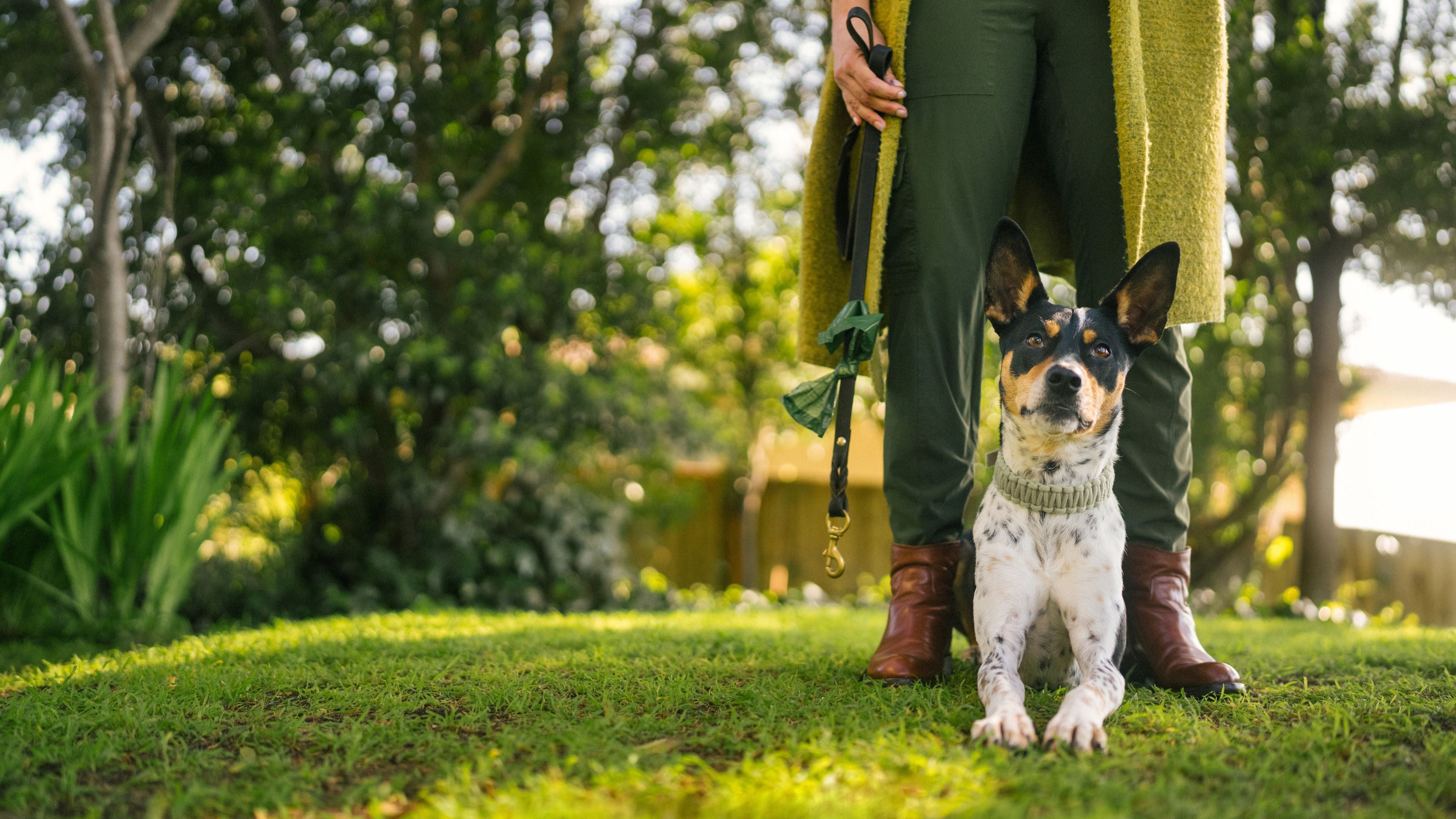While getting a new puppy is one of the most exciting things a person can do, setting yourself up for success does require some effort. Learning the best ways to train a young pup will result in a happier dog (and a happier you)!
A recent study found that effective training in the first 3 to 6 months of your dog’s life provides a better outcome in their future behavior. So, getting started early, reinforcing good behaviors, and creating a harmonious bond with your pup are great puppy training tips for raising a well-behaved adult dog.
Looking for more useful training tips? Keep on reading!
Setting the Foundation: Early Training Essentials
1. Potty Training: Outside Is Where to Go
The first thing that people are usually most eager to teach their new puppy is where to go to the bathroom: outside!
Your puppy will likely have accidents in the first few weeks. This is totally normal. Puppies, as a general rule, can hold their bladder for 1 hour for every month old they are (e.g., a 3-month-old puppy can hold their bladder for 3 hours max), but it’s always best to take them out more often.
Try to take your puppy outside at least once every 2 hours. It’s best to take them outside as soon as they wake up from their sleep/nap, after eating and drinking, and after playing.
If they do have an accident in the house, don’t punish them, as this might only teach them not to go in front of you. Instead, calmly wipe up the accident, and offer them no praise for going in the wrong place.
2. Crate Training: Keeping Your Puppy Safe
Your pup’s bed is among the most important things on your puppy supplies list to have ready. If you decide to crate your dog, it’s important to make sure the crate is seen by your dog as a safe space to prevent any anxiety or frustration.

You can do this in a few ways:
- Feed your dog their meals in their crate
- Leave them for only short stretches of time, gradually increasing how long they’re in the crate
- Save special treats and toys (such as a peanut butter-filled enrichment toy from Earth Rated) for the crate
- Never use the crate for punishment or timeouts
3. Socialization: Introducing New People and Animals
“The critical socialization period occurs between 8 and 16 weeks old,” explains Aryel Lafleur, a dog trainer and behavior consultant. ”It's crucial to expose puppies to various stimuli such as people, children, other dogs, sounds, textures, grooming manipulations, etc., during this period.”
This doesn't mean throwing them into potentially dangerous situations with new dogs or letting them run around the dog park before they’ve been vaccinated! Simply carrying your puppy around or letting them watch people from the safety of your car, or from the other side of the street, can be a huge help in socializing them.
Make sure to provide plenty of rewards and treats while introducing them to something new to create a positive association.
4. Creating a Schedule: Puppies Thrive on Consistency and Routine
One of the best puppy training tips is to create a schedule for them.
Puppies thrive on consistency and routine. If they have specific meal and nap times throughout the day, they know what to expect. This will help prevent them from becoming overtired and keep you on track so you don’t forget anything.
5. Bonding: Don’t Forget to Have Fun
Try not to get so caught up in a training program that you forget to bond with your puppy and have fun!
Taking plenty of time to just play and enjoy each other’s company will create a loving bond between you and your dog that will set you both up for success.
Basic Obedience Commands
When it comes to teaching your puppy the basic obedience commands, Aryel recommends being consistent and avoiding grey areas or half measures. Why? Inconsistency can actually confuse both you and your dog.
1. Sit
‘Sit’ is, of course, one of the easier commands for basic puppy training.
Place a treat above their nose and wait for them to sit, so they can look up to see the treat. When they do, quickly praise them and let them have the treat.
When they’re doing this consistently, add the verbal cue ‘sit’ right before they sit down, and they should soon catch on to what it means.
2. Lay Down
‘Lay down’ is often the next stage after ‘sit,’ for basic obedience training.
When your puppy is sitting, put a treat on the floor and gently drag it away from them to lure them down to the floor. The same way you taught ‘sit,’ quickly praise them the moment they lie down and release the treat.
When they’re doing it consistently, you can add in the verbal cue ‘lay down.’
3. Shake
‘Shake’ is a cute trick that’s relatively easy to teach your puppy!
Gently tickle your dog’s paw or lure them to put their paw up towards you, and praise and reward when they do. You can then add the verbal cue ‘shake.’
It’s important not to pick up your dog’s paw for them, as they should learn to do it themselves.

4. Stay
‘Stay’ can sometimes be more challenging to teach, but you can start working on it from a young age for the best success.
Tell your dog to ‘stay’ and then praise and reward when they do. Start off with very small time increments; even just saying ‘stay’ and then immediately rewarding them is enough.
Increase the time you ask them to ‘stay’ by a second or so every time you practice, and they should catch on.
5. Come
‘Come’ is perhaps the most important command you’ll teach your puppy, as having good recall is important for their safety.
Use the command while making coming to you fun! Run away from them with a toy, drag a treat, do whatever motivates your dog, and reward them when they come toward you.
You can increase the distance every time you do this, though it’s a good idea to use a long leash in an unfenced area until your dog’s recall is solid.
Positive Reinforcement Techniques
Studies have shown that positive reinforcement techniques and reward-based training are the most effective ways to train a dog. It provides motivation for your dog to communicate with you and obey any commands without the risk of stressing them out or creating fear.
Some examples of positive reinforcement training techniques include:
- Providing a treat or toy for performing a desired behavior, and keeping training sessions short to hold their attention
- Using a clicker to mark good behavior, and teaching them that the sound of the clicker comes with a reward
- Ignoring bad behavior and habits so as not to reward them, but not punish them either
- Figuring out what motivates your dog best—for some, this might be treats, for others, this might be toys, play, or praise
- Slowly weaning off constant rewards for commands your dog becomes strong at, so they aren’t needed all the time
Aryel also says it’s important to lower your expectations. “Remember, puppies are babies and cannot be expected to have the same level of obedience as adult dogs. Focus on building success gradually by starting with easy tasks and progressing to more complicated behaviors.”
Addressing Common Behavior Problems
One question that first-time dog owners who plan to use positive reinforcement training often ask is what to do if their dog has an undesirable behavior. How can you correct it without punishing them?
Here are some common behavioral issues and how to address them.
1. Leash Pulling
Loose leash walking takes many months to achieve, and a lot of patience and consistency. But, don’t give up!
You can practice by holding a treat or toy by your side and having your puppy walk by your side as their attention will be on that. Reward them for having a loose leash.
Start in a very calm environment, even inside of your own home. You can work up to an environment with more distractions.

2. Jumping on People
Jumping on people is a natural behavior for puppies to express their excitement, but it isn’t always well received. Especially when people get knocked over! 😬
If your puppy jumps on you, turn your back and ignore them until they’re calm, and don’t mirror their excitement. When all 4 paws are on the floor, pay them attention and praise them.
If you can do this consistently (and encourage guests to do the same), your puppy will soon learn that they get attention only when they’re calm.

3. Chewing, Chewing, and More Chewing!
When your puppy is going through the teething stage (which starts at around 12 weeks), they may be more prone to chewing on whatever they can get their sharp little teeth on - especially when they’re trying to ease the discomfort.
Providing plenty of outlets for their chewing is helpful, such as soaking a dish towel and then freezing it, or buying specific teething toys. The Earth Rated Tug Toy can be a great outlet for teething puppies.
Aryel suggests identifying when these behaviors occur most frequently and offering chew toys preemptively before the undesirable behaviors occur.

4. Barking at New People and Sounds
Dogs will naturally bark at new people and sounds to alert you to their presence, and some breeds are more prone to this than others. Teaching a ‘quiet’ command can be very useful.
When there’s a break in the barking, tell them ‘quiet’ and then immediately praise and reward. After staying consistent with this, you should be able to use the command when they’re barking and have them fall silent.
5. Biting and Nipping
Puppies can also be prone to biting and nipping.
When your puppy bites, stand up, walk away, and don’t pay them attention until they stop. They will soon learn that biting gets them no attention.
For particularly mouthy pups, redirection can also be helpful. Make sure to have a chew toy handy and, when they go for your hands, give them the toy instead to teach them what’s appropriate to bite.
Training Tips for Specific Situations
1. Leaving Your Puppy Alone
Puppies can easily develop separation anxiety which is thought to affect up to 1 in 4 dogs. So, teaching them how to be alone is key. Provide safe distractions when they’re home alone, such as a special toy or treat (only ones that are appropriate without supervision).
2. Meeting New People
Introducing your puppy to new people and ensuring these people follow your example of rewarding calm behavior is how to make your puppy a socially confident expert!
Have your guests pay your puppy attention only when they’re behaving well, and introduce them to lots of different people to give them a wide range of experiences.
3. Car Trips
Some puppies take to car trips more naturally than others, but any dog can be a car co-pilot with the right training.
It’s a good idea not to feed your puppy right before a car trip, as they might get sick. A few special treats, lots of praise and attention, and lots of initially short trips can go a long way. You can even try bringing a book, or laptop to the car, with your dog, to get them used to being in it with you, even when it’s not in motion.

4. Public Spaces
Some dogs get more excited than others in public spaces. If you want to be able to eat on a patio with your pup or take them on busy walking routes, starting as early as you can is a good idea.
Start with short durations, make sure to leave if your puppy becomes overwhelmed, and reward any calm behavior with their favorite treat or toy.
5. Visiting the Vet
Some dogs can also become very nervous when visiting the veterinarian.
Make the vet’s office a positive experience. You can do this by taking them to the reception even when they don’t have an appointment and getting them a pup cup on the way home, so not every vet visit has to be uncomfortable!
Consistency and Patience: Keys to Success
Consistency and patience are the keys to success in puppy training. If you find yourself becoming overwhelmed, it’s okay to take a break—it’s natural to become frustrated, for both you and your puppy.
But the frustrating moments will soon be overshadowed by the good ones if you follow these dog training tips. You won’t always see results right away, but if you stick to it, you’ll have the best sidekick ever.
Commonly Asked Questions
What Is the First Thing You Should Train Your Puppy?
Although it can be tempting to dive straight into commands, the first thing you should train your puppy is anything that involves shaping good habits. Reward them for going potty outside, for settling inside, and for any good habits you want to be lifelong.
What are the Seven Commands to Teach a Puppy?
The seven most important commands to teach a puppy are:
- ‘Come’
- ‘Sit’
- ‘Stay’
- ‘Lay down’
- ‘Leave it’
- ‘Heel’
- ‘Their Name’ (or a word that grabs their attention!)
What Is the Fastest Way to Train a Puppy?
There is no quick puppy training timeline, as proper training takes months of consistency. But, using positive reinforcement, staying consistent, and building a bond with your dog ensures that everything will pay off and you’ll have a well-behaved adult dog.
What Is the Best Age to Start Puppy Training?
The best age to start puppy training is the moment you have your puppy home. It’s never too early to start shaping and rewarding good behaviors and making it clear to your new best friend exactly what you want from them.








